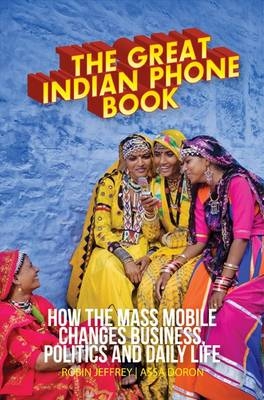
The Great Indian Phonebook
How the Mass Mobile Changes Business, Politics and Daily Life
Seiten
2013
C Hurst & Co Publishers Ltd (Verlag)
978-1-84904-192-8 (ISBN)
C Hurst & Co Publishers Ltd (Verlag)
978-1-84904-192-8 (ISBN)
- Titel ist leider vergriffen;
keine Neuauflage - Artikel merken
The cheap mobile phone is arguably the most significant personal communications device in history. In India, where caste hierarchy has reinforced power for generations, the disruptive potential of the mobile phone is even more striking than elsewhere.The book probes the whole universe of the mobile phone.
The cheap mobile phone is arguably the most significant personal communications device in history. In India, where caste hierarchy has reinforced power for generations, the disruptive potential of the mobile phone is even more striking than elsewhere. In 2001, India had 35 million telephones, only four million of them mobiles. Ten years later, it had more than 800 million phone subscribers; more than 95 per cent were mobile phones. In a decade, communications in India have been transformed by a device that can be shared by fisherfolk in Kerala, boatmen in Banaras, great capitalists in Mumbai and powerwielding politicians and bureaucrats in New Delhi. Village councils banned unmarried girls from having mobile phones. Families debated whether new brides should surrender them. Cheap mobile phones became photo albums, music machines and radios. Religious images and uplifting messages flooded tens of millions of phones each day. Pornographers and criminals found a tantalising new tool.
In politics, organisations with cadres of truebelievers exploited a resource infinitely more effective than telegrams, postcards and the printing press for carrying messages to workers, followers and voters. Jeffrey and Doron focus on three groups - controllers: the bureaucrats, politicians and capitalists who wrestle over control of radio frequency spectrum; servants: the marketers, agents, technicians, tower-builders, repairers and second-hand dealers who carry mobile phones to the masses; and users: the politicians, activists, businesses and households that adapt the mobile phone to their needs. The book probes the whole universe of the mobile phone - from the contests of great capitalists and governments to control radio frequency spectrum to the ways ordinary people build the troublesome, addictive device into their daily lives.
The cheap mobile phone is arguably the most significant personal communications device in history. In India, where caste hierarchy has reinforced power for generations, the disruptive potential of the mobile phone is even more striking than elsewhere. In 2001, India had 35 million telephones, only four million of them mobiles. Ten years later, it had more than 800 million phone subscribers; more than 95 per cent were mobile phones. In a decade, communications in India have been transformed by a device that can be shared by fisherfolk in Kerala, boatmen in Banaras, great capitalists in Mumbai and powerwielding politicians and bureaucrats in New Delhi. Village councils banned unmarried girls from having mobile phones. Families debated whether new brides should surrender them. Cheap mobile phones became photo albums, music machines and radios. Religious images and uplifting messages flooded tens of millions of phones each day. Pornographers and criminals found a tantalising new tool.
In politics, organisations with cadres of truebelievers exploited a resource infinitely more effective than telegrams, postcards and the printing press for carrying messages to workers, followers and voters. Jeffrey and Doron focus on three groups - controllers: the bureaucrats, politicians and capitalists who wrestle over control of radio frequency spectrum; servants: the marketers, agents, technicians, tower-builders, repairers and second-hand dealers who carry mobile phones to the masses; and users: the politicians, activists, businesses and households that adapt the mobile phone to their needs. The book probes the whole universe of the mobile phone - from the contests of great capitalists and governments to control radio frequency spectrum to the ways ordinary people build the troublesome, addictive device into their daily lives.
Robin Jeffrey is a Visiting Research Professor at the National University of Singapore and the author of India's Newspaper Revolution also published by Hurst. Assa Doron is an Australian Research Council Future Fellow in the Department of Anthropology, School of Culture, History and Language, the Australian National University. He is author of Caste, Occupation and Politics on the Ganges: Passages of Resistance.
| Erscheint lt. Verlag | 18.2.2013 |
|---|---|
| Zusatzinfo | illustrations |
| Verlagsort | London |
| Sprache | englisch |
| Maße | 245 x 225 mm |
| Themenwelt | Informatik ► Weitere Themen ► Smartphones / Tablets |
| Naturwissenschaften | |
| Sozialwissenschaften | |
| Technik ► Nachrichtentechnik | |
| ISBN-10 | 1-84904-192-X / 184904192X |
| ISBN-13 | 978-1-84904-192-8 / 9781849041928 |
| Zustand | Neuware |
| Haben Sie eine Frage zum Produkt? |
Mehr entdecken
aus dem Bereich
aus dem Bereich
der schnelle Smartphone-Einstieg : für alle Pixel-, Nokia-, Motorola- …
Buch | Softcover (2023)
BILDNER Verlag
14,90 €


